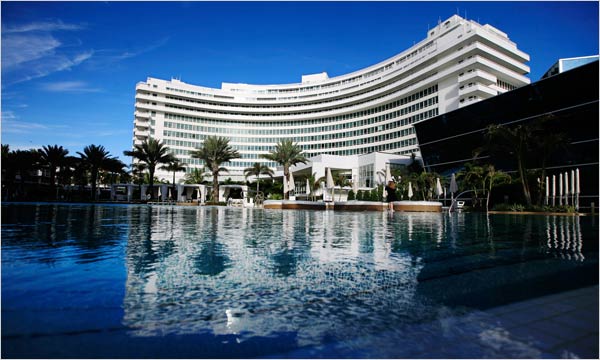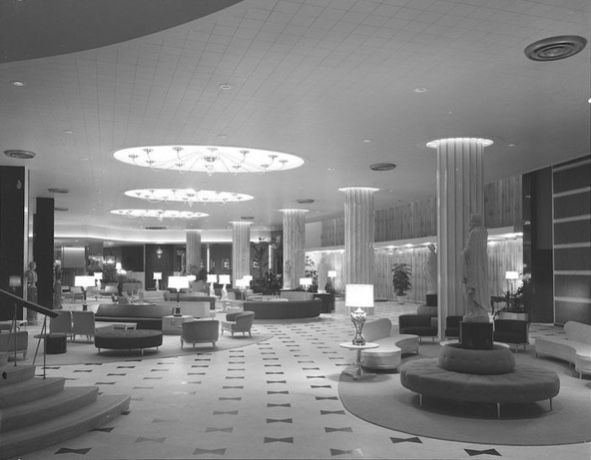
This post is also available in:

Emblematic example of MiMo style -Miami Modern architecture- to this day the Fontainebleau of Miami Beach is, for historical and architectural importance, a revered landmark of the city. Built in 1954, by Morris Lapidus at the behest of Ben Novack whom, identifying in Miami Beach the hub of the Golden Coast, in 1952 bought for $ 2.3 million dollars from the tycoon Harvey Firestone, the Firestone Mansion, with the intention of creating the largest, most luxurious, Florida hotel.
Located on Collins Avenue, in the heart of Millionaire’s Row, the Fontainebleau covers a 22-acre sea-view area, for a total of 1504 rooms distributed in different towers. The original central structure designed by Lapidus, include the Chateau Tower curve similar to a whale and the Versailles, the Trésor and the Sorrento Towers, were then built at a later time.

Inside the Fontainebleau there are 12 more or less formal restaurants, some of which are run by award-winning chef-celebrities. Among them are Scarpetta restaurant by chef Scott Conan of Italian-New York recall, the Stripsteak by chef Michael Mina and the flagship , Cantonese Hakkasan for an out-of-the-ordinary culinary experience. The hotel has two lounges, the state-of-the-art conference and event facilities of Lapis, a spa with a two-storey saloon, defined by Martha Stewart “the most beautiful spa in America”, a spectacular swimming pool surrounded by cabanas and above all kilometers of pristine beach.

But if it is true that Miami is the city of sunshine state is equally true that the city is renowned for the vibrant nightlife that finds in the Fointainebleau two of the most famous places in the city: the ultra exclusive LIV that in summer 2017 underwent restructuring for the price of 10 million dollars, promising crazy experiences at 360 degrees and the Bleaulive, in which during the golden days Frank Sinatra with the Rat Pack and Elvis Priestley have performed in shows that have consecrated the Fontainebleau as the sacred temple of celebrities. Franck Sinatra, Dean Martin had a permanent suite while Jerry Lewis, Jane Mansfield, Joan Crawford and John Kennedy stayed there with all the political, financial and Hollywood skies of the time scenario. He also appeared in numerous films including Goldfinger, The Bellboy, Scarface, The Specialist and Bodyguard, which have done nothing but increase its appeal despite prohibitive prices.

After the 2005 makeover for which the hotel closed its doors until 2008, with a total investment of 1 billion dollars the hotel was transformed into a resort. The change was directed by Jeffrey Soffer, owner of property in Las Vegas. The Resort reopened with a bang at the Victoria’s Secret Fashion Show and performers such as Usher, Mariah Carey and Robin Thicke. The show was broadcasted nationwide on CBS, and since then Lady Gaga, Maroon 5, Katy Perry, Jennifer Lopez and many other artists have performed on the Blueaulive stage.

The most interesting part of the Fointainebleau, which in 2012 received the award for the Top Building of Florida in the competition “100 Years 100 Places from the American Institute of Architects ” remains however the opulent lobby of the Chateau Tower, to consecrate a style praised by some and denigrated by others. Lapidus had imagined the hotel lobby as a theater where people could see and be seen satisfying their narcissistic spirit that took shape: “If you create the stage setting and it’s great, everyone who enters will do their part,” he said in an interview.


Original of the period, The Fountainbleau, with its 17,000 feet of surface (1580 square meters) boasts some of the distinctive features of Morris Lapidus’s architecture, starting with the brass entrance handles representing a seahorse as well as the Fountainebleau “F”, the white marble pavement interrupted by black papillon shapes, the imposing crimson columns and the famous Stairway to Nowhere staircase, which never leads anywhere, but which offers the opportunity to make a sparkling descent into the lobby. On the walls of the front of the Convention Center, a set of circular windows, ironically called by the architect the cheeseholes, give the feeling of being in a submarine, as well as the interior walls, curvilinear give the idea to float and move in snaking lines, this is because according to Lapidus people never walk in a straight line.

Following the imposing renovation of 2005 the hotel has undergone a modernization becoming a spectacular blend of glamor of the Miami golden age mixed with the modern and elegant luxury of today’s times, starting from the luxurious and elegant rooms each with custom iMacs. The design of the light, fundamental to the Fointainebleau, was entrusted to James Turrell, an American artist whose works focus mainly on the perception of light and space, whom created three light sculptures behind the hotel reception and long light groups in the hall that leads to the main lobby. The best characteristic of these sculptures is that it is difficult to capture their color because the light is slowly transformed from one color palette to another. The chandeliers of Lapidus have been replaced by three spectacular circular chandeliers composed of thousands of crystal pendants by the artist Ai Weiwei, which echo the cheeseholes of the walls.

Numerous works of art can also be seen in the elegant boutiques; of particular charm is the Fragile Future chandelier of the jewelry made of a metallic structure in phosphor bronze, LED and real dandelion, by Lonneke Gordijn and Ralph Nauta of Studio Drift, in which nature and technology mix together.

Throughout his long career, Lapidus, to whom shortly before his death in 2001 was conferred the prestigious National Design Award of Smithsonian’s National Museum of Design Cooper Hewitt, has designed more than a thousand buildings including 250 hotels, some of the most famous in Miami, among them the Fontainebleu, which he called his masterpiece: “It was completely fabulous in a way that horrified the architectural establishment of the time – but the public understood and loved it,” he declared. In fact, with this very demanding work he managed to make room among the architects of the time and to work at many other hotels on Collins that still bear his mark and his signature and that give to Miami Beach the charm for which it is known.
